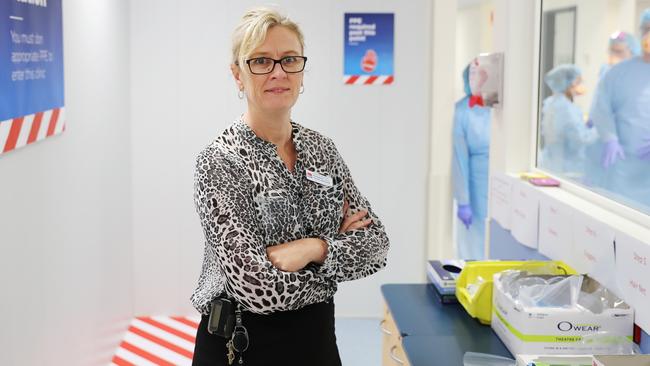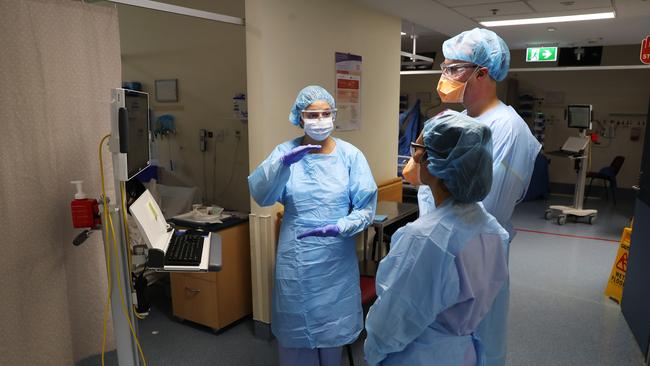Inside the COVID-19 ICU ready for the pandemic
They are Australia’s quietly spoken frontline heroes already dealing with the coronavirus pandemic and braced for much worse to come — the doctors and nurses of units such as RPA’s specialist “Red” COVID-19 intensive care facility.
NSW Coronavirus News
Don't miss out on the headlines from NSW Coronavirus News. Followed categories will be added to My News.
They are Australia’s quietly spoken frontline heroes already putting their lives on the line with the escalating coronavirus pandemic — and they’re braced for much worse to come.
On Thursday The Daily Telegraph went inside Royal Prince Alfred Hospital’s purpose-built “Red” COVID-19 intensive care unit to meet the doctors and nurses suiting up for battle.
“Anyone who says they are not worried about dying would be few and far between,” intensive care specialist Dr Tim Southwood said.

But despite the concerns the call-out for volunteers to staff the new COVID “Red” unit resulted in responses far beyond what was needed. For now.
The 16-bed unit was built from scratch in just one week and has only been open for five days. It already has nine patients.
Every doctor and nurse in the unit wears surgical scrubs, plastic gowns, gloves, sealed breathable masks, goggles and a head covering.
A member of the newly formed “Tiger Team” is on duty at the sealed entrance to the unit to ensure no step in the rigorous sanitising and personal protection equipment regimen is missed. Another Tiger Team member repeats the process in reverse as they leave.

The medical staff are literally placing their lives and those of their families and loved ones in the effectiveness of those world standard processes.
“It is frighteningly simple,” Dr Southwood said, pumping hand sanitiser onto his hands for the fourth time in as many minutes. “Hand hygiene.”
“I am worried about family and friends at work catching it,” he said. “But I don’t think I am any more worried about catching COVID-19 in here than I would be walking around on the street.”
Medical staff on the coronavirus frontline in other countries have succumbed to the disease in alarming numbers, with speculation that repeated exposure to the virus can increase its impact.
Across Italy, France and Spain more than 30 health care professionals have died from the virus.

In Spain 14 per cent of the country’s 40,000 confirmed coronavirus cases are medical professionals — 5400 badly needed doctors and nurses off work and in isolation.
“We are all worried that could be a possibility here. We have seen that happen in Italy and Wuhan,” Dr Southwood, 40, said.
He concedes his wife Lauren, mother of their two young children, is worried. “But I think she is confident that we can do this.”
By that he means meet the pandemic head on when it really hits.
“Everything we have done with the ‘Red’ unit is scalable,” he said.
The new unit increases the hospital’s intensive care bed capacity from 54 to 70 with the 11 Green intensive care beds also currently dedicated to COVID-19.
Surge planning means that staff, equipment and beds have been identified to expand across the entire third level of the hospital to make it a giant COVID-19 intensive care ward.

NSW Chief Health Officer Dr Kerry Chant on Thursday confirmed NSW had 500 ventilators with 16 coronavirus patients in ICU.
She has said she is looking to double those ventilator numbers.
Health Minister Greg Hunt said the country’s ventilator capacity in ICUs would be increased from 2000 to 4000 by better using existing units in hospitals.
“They are using spare machines, they are using machines that have been, you know, sometimes put aside as backups, machines that might have been replaced by the absolute latest,” he said. “But then we’re going into production.”
Mr Hunt said the government had tasked local companies to adapt similar products for use as ventilators.
“We have commissioned with ResMed … they do sleep apnoea machines but they also have a capacity with ventilators and the capacity to adapt what they do,” he said.
Combined with anaesthetic companies that would create an additional five thousand ventilators.

Despite this Dr Southwood is still desperate for people to self isolate and slow the spread of the virus because “I am concerned that the health system will not cope”.
Downstairs at RPA in Camperdown a completely new coronavirus emergency department has been set up to receive and test people who believe they may have the virus.
At its peak last week it was testing 460 people a day.
“After every swab our staff have to remove their gloves and sanitise their hands,” emergency physician Dr Dane Chalkley said. “Their hands are red raw by the end of the day.”
The doctors and nurses on duty are completely covered in the same personal protection equipment as the COVID “Red” unit staff.
“It is very isolating because you cannot see anyone’s emotion. And it is hot being encased in plastic.”

However the physical problems are not the ones worrying Dr Chalkley, 46, a father of two, who is bracing for the next phase of the outbreak.
“Pandemics change. At the moment we are in containment mode and trying to reduce the number of people who catch the virus and come into the hospital system at the same time.
“The next phase will be seeing sick people come here in significant numbers. When we get to that point we will have to revisit all of our procedures and change them,” he said.
There is an escalation plan in place to cope with that “when” it happens.
COVID-19 emergency department nurse Lucy McWilliams, 35, said: “I am a little bit nervous because it is hard to anticipate what’s going to come.
“If it gets to the point like Italy we will be having to make decisions on who gets put on a ventilator and who doesn’t.
“It will also be absolutely devastating for our staff.”

